
Interstate 4 (I-4) is an Interstate Highway located entirely within the US state of Florida, maintained by the Florida Department of Transportation (FDOT). Spanning 132.30 miles (212.92 km) along a generally southwest–northeast axis, I-4 is entirely concurrent with State Road 400 (SR 400). In the west, I-4 begins at an interchange with I-275 in Tampa. I-4 intersects with several major expressways as it traverses Central Florida, including US Highway 41 (US 41) in Tampa; US 301 near Riverview; I-75 near Brandon; US 98 in Lakeland; US 27 in unincorporated Davenport; US 192 in Celebration; Florida's Turnpike in Orlando; and US 17 and US 92 in multiple junctions. In the east, I-4 ends at an interchange with I-95 in Daytona Beach, while SR 400 continues for roughly another four miles (6.4 km) and ends at an intersection with US 1 on the city line of Daytona Beach and South Daytona.
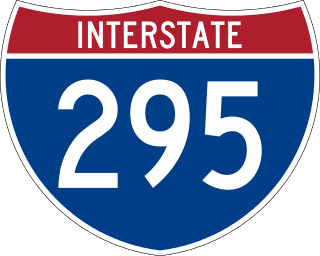
Interstate 295 (I-295), an auxiliary route of I-95, is a beltway around central Jacksonville, Florida, United States. The 61.04-mile-long (98.23 km) beltway consists of two segments, the West Beltway and the East Beltway, with I-95 serving as the dividing line between the two. The entire highway carries a hidden designation as SR 9A by the Florida Department of Transportation (FDOT). The West Beltway was constructed in the 1970s, with the East Beltway being built from the 1980s to the 2000s.

The St. Elmo W. Acosta Bridge spans the St. Johns River in Jacksonville, Florida on a fixed span. It is named for City Councilman St. Elmo W. Acosta, who convinced voters to approve a $950,000 bond issue for the original bridge at the site. It carries a total of six lanes of SR 13 with the two-track Jacksonville Skyway in the median and sidewalks on the outside.

The Fuller Warren Bridge is the prestressed-concrete girder bridge that carries Interstate 95 (I-95) across the St. Johns River in Jacksonville, Florida. The current structure was finished in October 2002, replacing the original bascule-bridge span, finished in 1954.
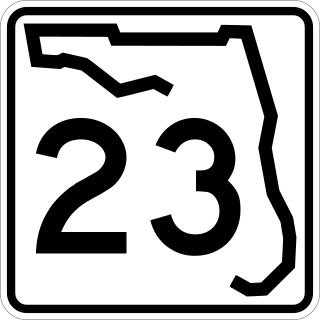
State Road 23 (SR 23), also known as the First Coast Expressway, is a controlled-access toll road serving as an outer bypass around the southwest quadrant of Jacksonville. As of 2024, the first phase has been built, linking the Middleburg area to Interstate 10 near Whitehouse, with the second phase is currently under construction and will be completed in 2030.

The Jacksonville Transportation Authority (JTA) is the independent agency responsible for public transit in the city of Jacksonville, Florida, and roadway infrastructure that connects northeast Florida. However, they do not maintain any roadways. In 2023, the system had a ridership of 6,687,200, or about 22,300 per weekday as of the fourth quarter of 2023.
The Isaiah David Hart Bridge is a truss bridge that spans the St. Johns River in Jacksonville, Florida. It carries U.S. Route 1 Alternate and State Road 228 (SR 228). It is named after Isaiah Hart, the founder of Jacksonville and is often referred to as the Hart Bridge. It was designed by Sverdrup & Parcel. The Hart Bridge is one of the longest truss bridges in the world, and has the world's third longest main span of any truss bridge.

The Shands Bridge is a two-lane automobile bridge carrying SR 16 over the St. Johns River south of Jacksonville, Florida.

The Bridge of Lions is a double-leaf bascule bridge that spans the Intracoastal Waterway in St. Augustine, Florida, United States. A part of State Road A1A, it connects downtown St. Augustine to Anastasia Island across Matanzas Bay. A pair of copies of the marble Medici lions guard the bridge, begun in 1925 and completed in 1927. They were removed in February 2005 and returned in March 2011.

Gandy Bridge is the southernmost bridge spanning Old Tampa Bay from St. Petersburg, Florida to Tampa, Florida. The original 1924 span was dismantled in 1975. The second bridge, constructed in 1956 was used for vehicular traffic until 1997, when it was converted to recreational use by non-motorized traffic. It became known as the Friendship Trail Bridge and was demolished in 2016, after closing in 2008 due to hazardous conditions and several failed efforts to preserve the span. The third (1975) and fourth (1997) spans of the Gandy Bridge are currently being used for vehicle traffic.

The Jacksonville Metropolitan Area, also called the First Coast, Metro Jacksonville, or Northeast Florida, is the metropolitan area centered on the principal city of Jacksonville, Florida and including the First Coast of North Florida. As of the 2020 United States census, the total population was 1,605,848. The Jacksonville–Kingsland–Palatka, FL–GA Combined Statistical Area (CSA) had a population of 1,733,937 in 2020 and was the 34th largest CSA in the United States. The Jacksonville metropolitan area is the 40th largest in the country and the fourth largest in the State of Florida, behind the Miami, Tampa, and Orlando metropolitan areas.
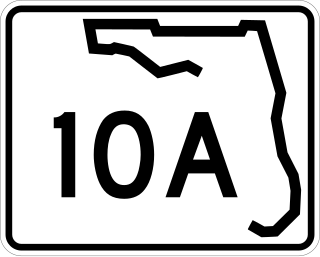
The Arlington Expressway, which carries the unsigned State Road 10A and mostly also the signed State Road 115 in Jacksonville, Florida, is a freeway that heads east from Downtown Jacksonville over the Mathews Bridge to Atlantic Boulevard at the Regency Square Mall.
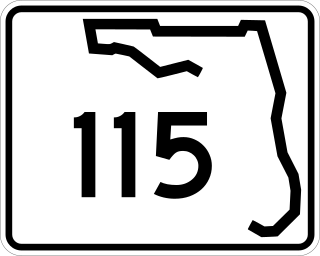
State Road 115 is a state highway in the U.S. state of Florida.

The Escambia Bay Bridge is a six-lane freeway bridge that carries Interstate 10 (I-10) across Escambia Bay near Pensacola, Florida.

The former St. Andrew's Episcopal Church building, also known as Old St. Andrew's Event Venue, is an historic building located at 317 Florida Avenue in downtown Jacksonville, Florida. It was originally an Episcopal church, but closed when the parish relocated to the suburbs in 1960. On May 4, 1976, the edifice was added to the U.S. National Register of Historic Places. In the 1990s it was purchased by the City of Jacksonville and turned over to the Jacksonville Historical Society (JHS), and now serves as an event venue managed by the society.

The Pensacola Bay Bridge, also known locally as the Three-Mile Bridge, runs between downtown Pensacola, Florida, and Gulf Breeze, Florida. It carries six lanes of U.S. Highway 98 across Pensacola Bay.

State Road 116 (SR 116) is a 9.026-mile-long (14.526 km) state highway in the northeastern part of the U.S. state of Florida. It travels nearly due west-east entirely within the city limits of Jacksonville, in Duval County. At its west terminus, SR 116 is signed as Merrill Road beginning at the intersection with Interstate 295 and SR 113 near the St. Johns River. At its eastern terminus, it is signed as Wonderwood Road, ending at the intersection with SR 101 just south of Naval Station Mayport. Here, the Wonderwood Road designation continues to Hanna Park.

The Francis P. Whitehair Bridge, also known as the Crows Bluff Bridge, was a double leaf bascule bridge located in Crows Bluff, Florida that carried State Road 44 over the St. Johns River. The original bridge on the site was constructed in 1917; replaced in 1955, and though it was previously expected to remain in service until the 2050s, a new version of the bridge opened in September of 2023.
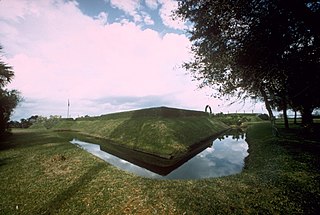
Arlington is a large region of Jacksonville, Florida, and is generally understood as a counterpart to the city's other large regions, the Urban Core, Northside, Southside, Westside, and the Beaches. It borders the Southside area at its southern end, and has several bridge connections to nearby beaches, the Northside and Downtown. The expansive neighborhood was incorporated into the city in 1968 as a result the Jacksonville Consolidation, a city-county consolidation of the governments of the City of Jacksonville and Duval County. Arlington is known for its mid-century modern architecture, and contains several architecturally significant homes designed by local architects Robert C. Broward, Taylor Hardwick, and William Morgan.

The Charles E. Bennett Memorial Bridge carries Florida State Road 116 traffic over the Intracoastal Waterway south of the St. Johns River in Jacksonville, Florida. It was named for Charles Edward Bennett, a member of the United States House of Representatives from Florida who was involved in the creation of Mayport Naval Station. The bridge is commonly referred to as the Wonderwood Bridge, as the bridge is located on Wonderwood Drive.

























